Thermal Impact of 5G Antenna Systems in Sandwich Walls
Abstract
1. Introduction
- To conduct 3D numerical modeling to determine the U-values of the developed signal-transmissive walls with stainless steel and copper used as connector materials.
- To compare the calculated U-values of the signal-transmissive walls with the same wall without a 5G passive antenna and to determine the additional heat loss and cost per year under Finnish weather conditions.
- To utilize analytical formulas to evaluate the U-values of the signal-transmissive walls, in order to identify a suitable and practical tool for future thermal studies of signal-transmissive walls.
2. Materials and Methods
2.1. The Wall Materials
2.2. Analytical Approaches
2.2.1. Parallel Path Method
2.2.2. Isothermal Planes Method
2.2.3. ISO 6946 Combined Method
2.3. Numerical Approach
3. Results and Discussion
3.1. Signal-Transmissive Walls
- In the current design, it can be assumed that the heat flows perpendicular to the planes of the building elements. However, in the previous design, the heat flow direction was no longer perpendicular to the planes of the building elements.
- Unlike the current design, in the previous design (Figure 12), the distribution of heat flow lines varied between different layers. For instance, in the insulation layer, the heat flow lines are distributed closer to the dual coaxial cable compared to other layers. This is because the thermal resistance of rockwool is much higher than that of the dual coaxial cable, which used copper as a center connector material.
3.2. Three by Three Signal-Transmissive Walls
- The current design (shown in Figure 14) has an insignificant thermal bridging effect, as the maximum temperature difference is less than 0.04 °C. However, the previous design exhibits clear thermal bridging effects with a maximum temperature difference of approximately 0.4 °C, as presented in Figure 15.
- The thermal bridging effect, as depicted in Figure 15, affects an area larger than that of a dual coaxial cable but smaller than the cell size of 150 mm × 150 mm. This observation is probably applicable to all planes that are perpendicular to the building elements.
- The thermal bridging effect, although small, cannot be disregarded in some planes of the current design.
- There is no evidence to suggest that the thermal behavior of a cell is dependent on its location in the 3 × 3 signal-transmissive wall. This is supported by the fact that all nine cells in a 3 × 3 signal-transmissive wall were found to have similar average surface conductive heat fluxes (Figure 13), and their temperature profiles for cut planes are also very similar and closely resemble those of standalone signal-transmissive walls (as demonstrated in Figure 15).
4. Conclusions
Author Contributions
Funding
Data Availability Statement
Acknowledgments
Conflicts of Interest
References
- Wikipedia. “5G”. Available online: https://en.wikipedia.org/wiki/5G (accessed on 1 February 2023).
- Gallagher, J.C.; DeVine, M.E. Fifth-Generation (5G) Telecommunications Technologies: Issues for Congress; CRS Report; Congressional Research Service: Washington, DC, USA, 2019.
- Nokia. 5G Deployment below 6 GHz Ubiquitous Coverage for Critical Communication and Massive IoT; White paper; Nokia: Espoo, Finland, 2018. [Google Scholar]
- Rodriguez, I.; Nguyen, H.C.; Jorgensen, N.T.K.; Sorensen, T.B.; Mogensen, P. Radio propagation into modern buildings: Attenuation measurements in the range from 800 MHz to 18 GHz. In Proceedings of the 2014 IEEE 80th Vehicular Technology Conference (VTC2014-Fall), Vancouver, BC, Canada, 14–17 September 2014; pp. 1–5. [Google Scholar]
- Haneda, K.; Zhang, J.; Tan, L.; Liu, G.; Zheng, Y.; Asplund, H.; Li, J.; Wang, Y.; Steer, D.; Li, C.; et al. 5G 3GPP-like channel models for outdoor urban microcellular and macrocellular environments. In Proceedings of the 2016 IEEE 83rd Vehicular Technology Conference (VTC Spring), Nanjing, China, 15–18 May 2016; pp. 1–7. [Google Scholar]
- Er-reguig, Z.; Ammor, H. Towards designing a microcell base station using a software-defined radio platform. In Proceedings of the 2019 7th Mediterranean Congress of Telecommunications (CMT), Fez, Morocco, 24–25 October 2019; pp. 1–4. [Google Scholar]
- Yunas, S.F. Capacity, Energy-Efficiency and Cost-Efficiency Aspects of Future Mobile Network Deployment Solutions. Ph.D. Thesis, Tampere University of Technology, Tampere, Finland, 2015. [Google Scholar]
- Haneda, K.; Kahra, E.; Wyne, S.; Icheln, C.; Vainikainen, P. Measurement of loop-back interference channels for outdoor-to-indoor fullduplex radio relays. In Proceedings of the Fourth European Conference on Antennas and Propagation, Barcelona, Spain, 12–16 April 2010; pp. 1–5. [Google Scholar]
- Rigelsford, J.M.; Ford, K.L.; Subrt, L. A passive system for increasing cellular coverage within energy efficient buildings. In Proceedings of the 8th European Conference on Antennas and Propagation (EuCAP 2014), The Hague, The Netherlands, 6–11 April 2014; pp. 614–615. [Google Scholar]
- Ntontin, K.; Verikoukis, C. Relay-aided outdoor-to-indoor communication in millimeter-wave cellular networks. IEEE Syst. J. 2020, 14, 2473–2484. [Google Scholar] [CrossRef]
- Asp, A.; Baniya, A.; Yunas, S.F.; Niemelae, J.; Valkama, M. Applicability of frequency selective surfaces to enhance mobile network coverage in future energy-efficient built environments. In Proceedings of the European Wireless 2015, 21th European Wireless Conference, Budapest, Hungary, 20–22 May 2015; pp. 1–8. [Google Scholar]
- Lammin Windows & Doors. “Signal Window.”. Available online: http://signal-window.com (accessed on 1 February 2023).
- Lilja, J. Mobile-friendly glass –comparing solutions from the end user viewpoint. In Proceedings of the Glass Performance Days 2019 (GPD2019), Tampere, Finland, 26–28 June 2019. [Google Scholar]
- Vähä-Savo, L.; Atienza, A.G.; Cziezerski, C.; Heino, M.; Haneda, K.; Icheln, C.; Lü, X.; Viljanen, K. Passive antenna systems embedded into a load bearing wall for improved radio transparency. In Proceedings of the 2020 50th European Microwave Conference (EuMC), Utrecht, The Netherlands, 12–14 January 2021; pp. 424–427. [Google Scholar]
- Vähä-Savo, L.; Haneda, K.; Icheln, C.; Lü, X. Electromagnetic-Thermal Analyses of Distributed Antennas Embedded into a Load Bearing Wall. arXiv 2022, arXiv:2207.06185. [Google Scholar]
- ISO 9869; Thermal Insulation—Buildings Elements—In-Situ Measurement of Thermal Resistance and Thermal Transmittance—Part 1: Heat Flow Meter Method. ISO—International Organization for Standardization: Geneva, Switzerland, 2014.
- Salmon, D. Thermal conductivity of insulations using guarded hot plates including recent developments and sources of reference materials. Meas. Sci. Technol. 2001, 12, R89. [Google Scholar] [CrossRef]
- ISO 8990; Thermal Insulation—Determination of Steady-State Thermal Transmission Properties—Calibrated and Guarded Hot Box. ISO—International Organization for Standardization: Geneva, Switzerland, 1994.
- Soares, N.; Martins, C.; Gonçalves, M.; Santos, P.; da Silva, L.S.; Costa, J.J. Laboratory and in-situ non-destructive methods to evaluate the thermal transmittance and behaviour of walls, windows, and construction elements with innovative materials: A review. Energy Build. 2019, 182, 88–110. [Google Scholar] [CrossRef]
- Martins, C.; Santos, P.; da Silva, L.S. Lightweight steel-framed thermal bridges mitigation strategies: A parametric study. J. Build. Phys. 2016, 39, 342–372. [Google Scholar] [CrossRef]
- Santos, P.; Martins, C.; da Silva, L.S.; Bragança, L. Thermal performance of lightweight steel framed wall: The importance of flanking thermal losses. J. Build. Phys. 2014, 38, 81–98. [Google Scholar] [CrossRef]
- ISO 6946; Building Components and Building Elements—Thermal Resistance and Thermal Transmittance—Calculation Methods. ISO—International Organization for Standardization: Geneva, Switzerland, 2017.
- Kosny, J.; Christian, J.E.; Barbour, E.; Goodrow, J. Thermal Performance of Steel-Framed Walls; ORNL report; Oak Ridge National Laboratory: Oak Ridge, TN, USA, 1994.
- ASHRAE. Handbook of Fundamentals (SI Edition); ASHRAE—American Society of Heating, Refrigerating and Air-Conditioning Engineers: Atlanta, GA, USA, 2017. [Google Scholar]
- Christensen, D. Thermal Impact of Fasteners in High-Performance Wood-Framed Walls; National Renewable Energy Lab. (NREL): Golden, CO, USA, 2010.
- SolidWorks. Introducing COSMOSWorks; Structural Research and Analysis Corporation (SRAC): Los Angeles, CA, USA, 2003. [Google Scholar]
- Santos, P.; Lemes, G.; Mateus, D. Analytical Methods to Estimate the Thermal Transmittance of LSF Walls: Calculation Procedures Review and Accuracy Comparison. Energies 2020, 13, 840. [Google Scholar] [CrossRef]
- Muzzi, T.A.; Souza, H.A.; Gomes, A.P. Heat transfer analysis of the vertical closing system in light steel framing using the isothermal planes method and finite element method. REM Int. Eng. J. 2021, 74, 425–431. [Google Scholar] [CrossRef]
- Kosny, J.; Yarbrough, D.; Childs, P.; Mohiuddin, A. Effects of Framing on the Thermal Performance of Wood and Steel-Framed Walls. In Proceedings of the Fifteenth Symposium on Improving Building Systems in Hot and Humid Climates, Orlando, FL, USA, 24–26 July 2006. [Google Scholar]
- Gorgolewski, M. Developing a simplified method of calculating U-values in light steel framing. Build. Environ. 2007, 42, 230–236. [Google Scholar] [CrossRef]
- Atsonios, I.A.; Mandilaras, I.D.; Kontogeorgos, D.A.; Founti, M.A. Two new methods for the in-situ measurement of the overall thermal transmittance of cold frame lightweight steel-framed walls. Energy Build. 2018, 170, 183–194. [Google Scholar] [CrossRef]
- Hagentoft, C.E. Introduction to Building Physics; Studentlitteratur: Lund, Sweden, 2001. [Google Scholar]
- COMSOL. Heat Transfer Module User’s Guide; COMSOL Inc.: Stockholm, Sweden, 2022. [Google Scholar]
- Ministry of the Environment of Finland. Decree of the Ministry of the Environment on Thermal Insulation; Ministry of the Environment of Finland: Helsinki, Finland, 2003. [Google Scholar]
- Finnish Meteorological Institute. Heating Degree Days. Available online: https://en.ilmatieteenlaitos.fi/heating-degree-days (accessed on 2 February 2023).
- Helen. District Heating Prices. Available online: https://www.helen.fi/en/heating-and-cooling/district-heat/district-heat-prices (accessed on 2 February 2023).
- Fortuna, L.; Buscarino, A. Smart Materials. Materials 2022, 15, 6307. [Google Scholar] [CrossRef] [PubMed]
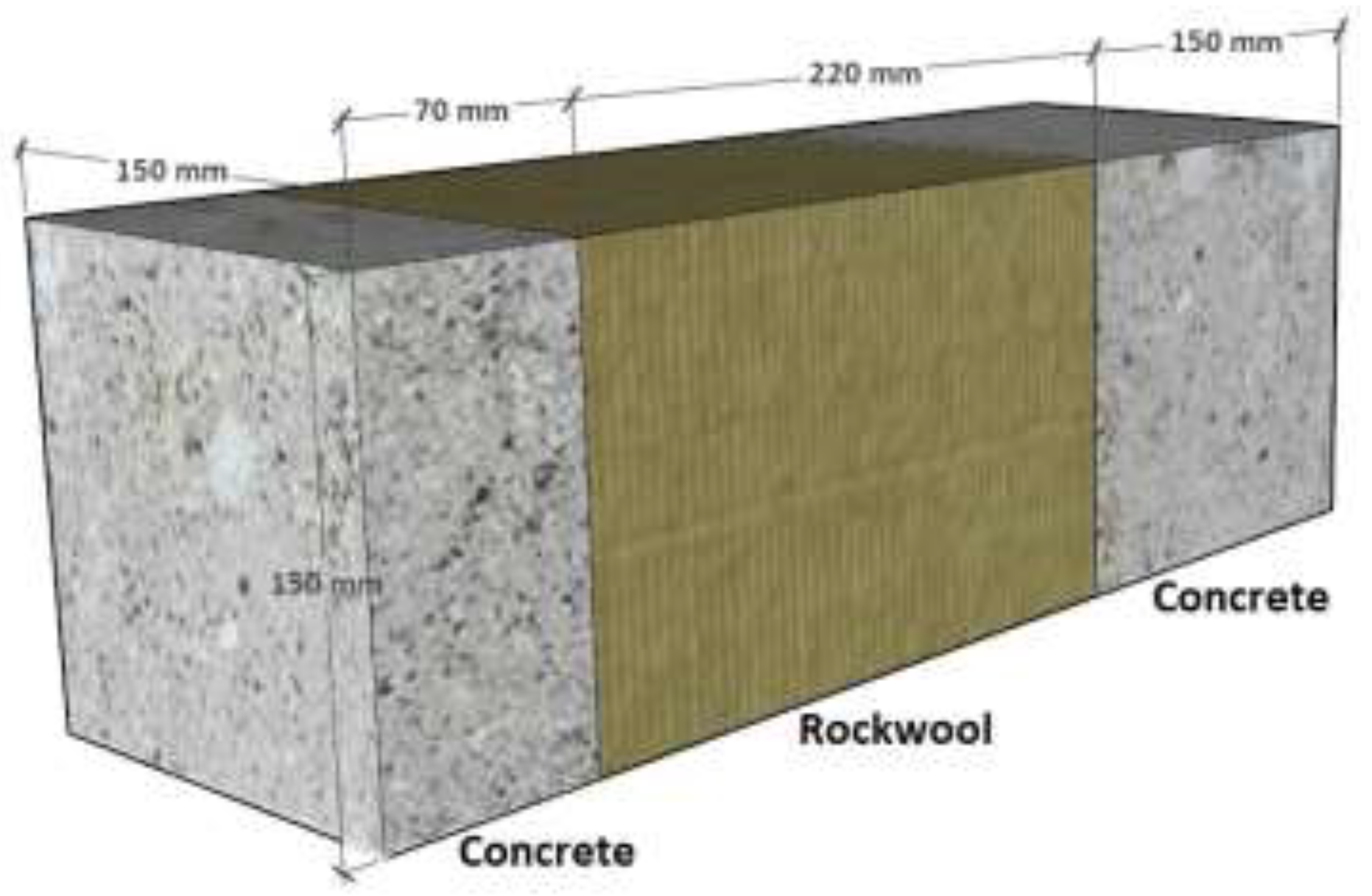

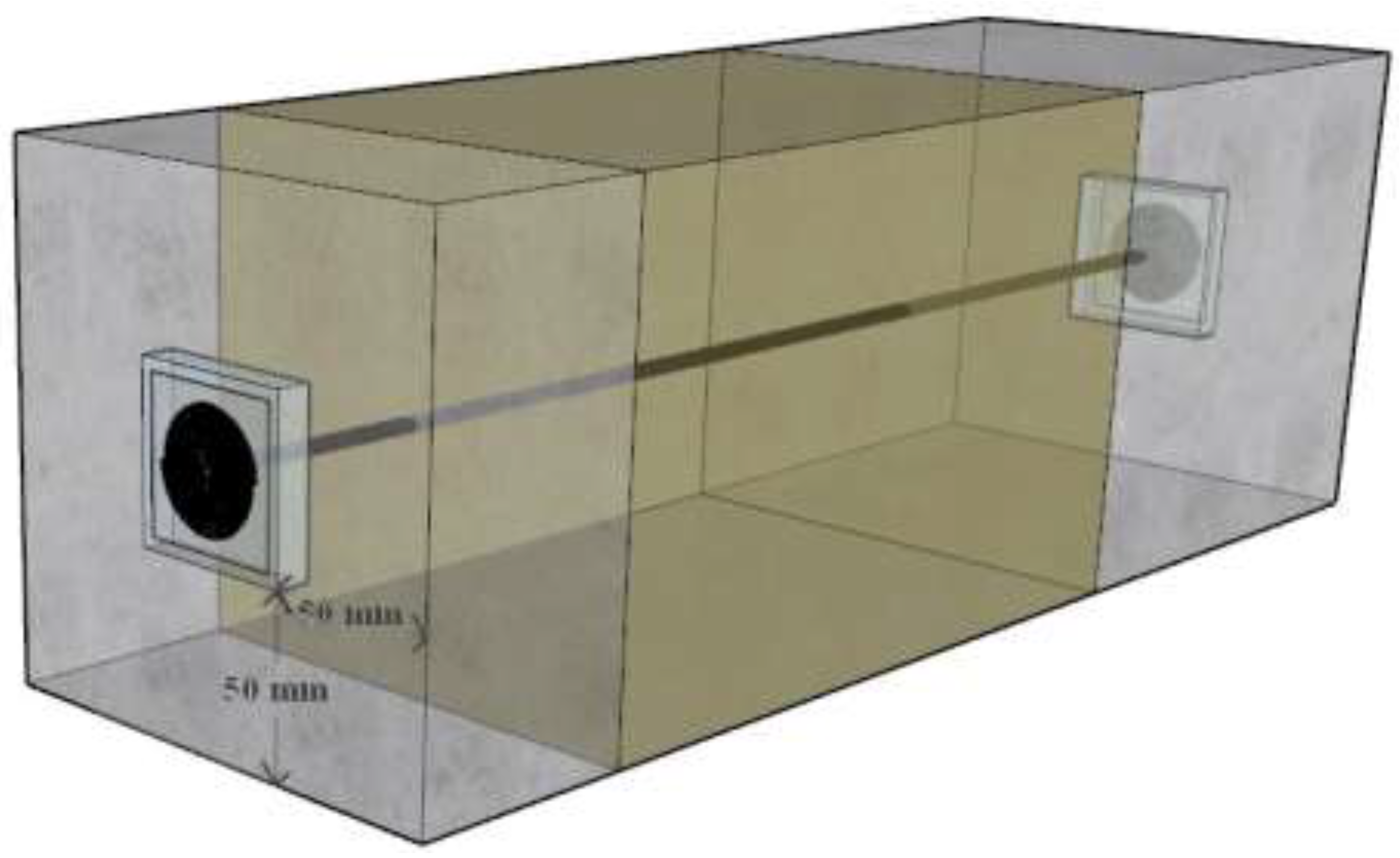
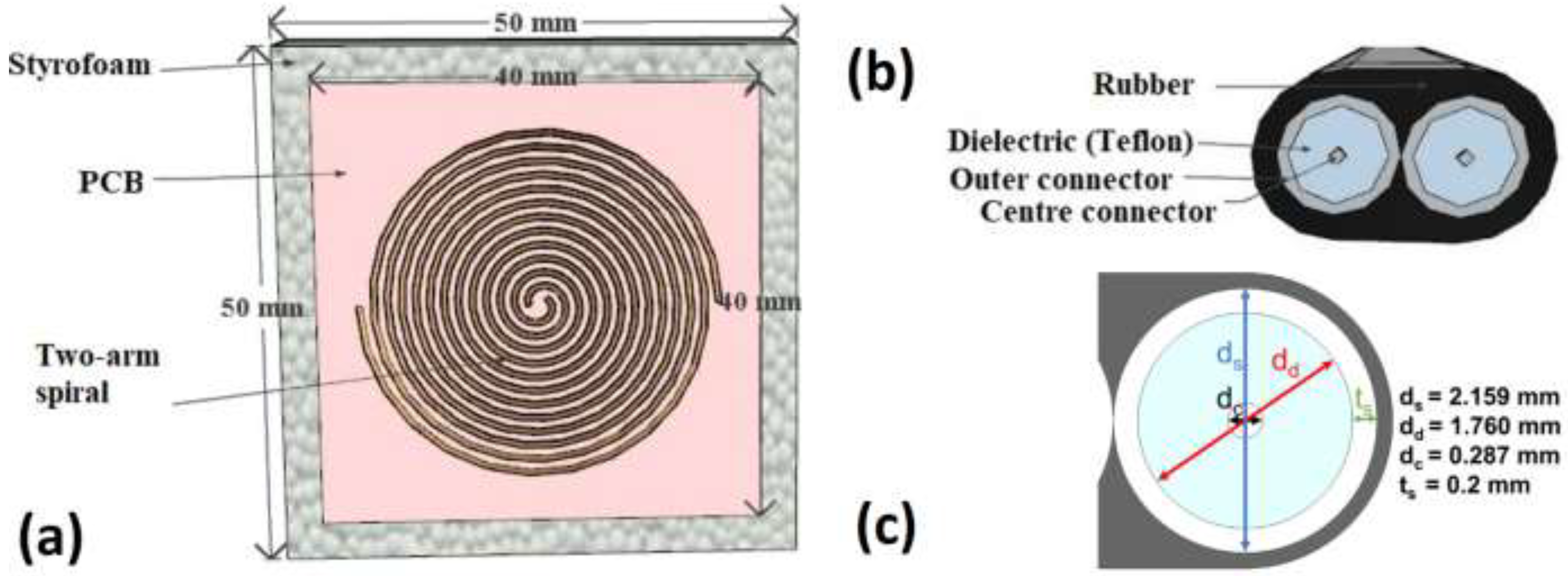
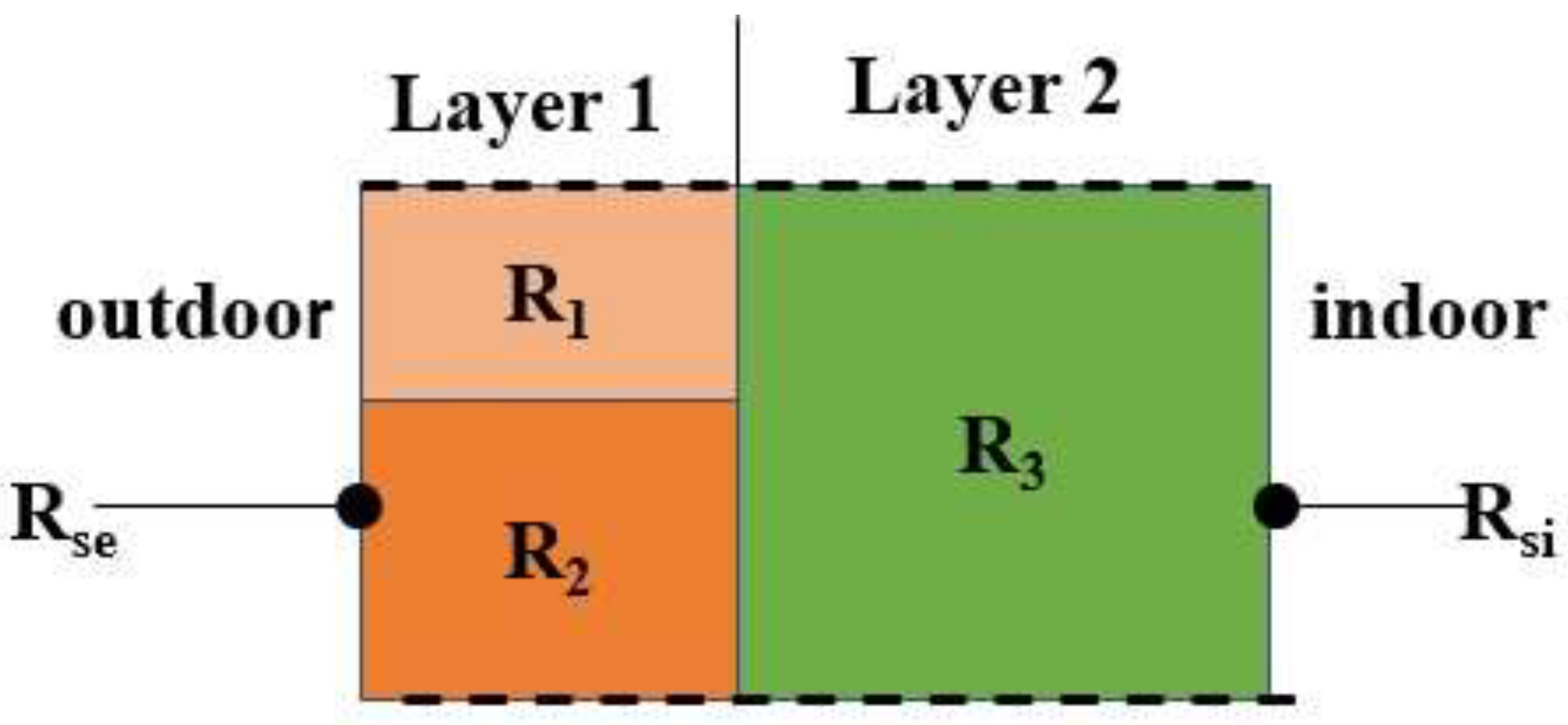

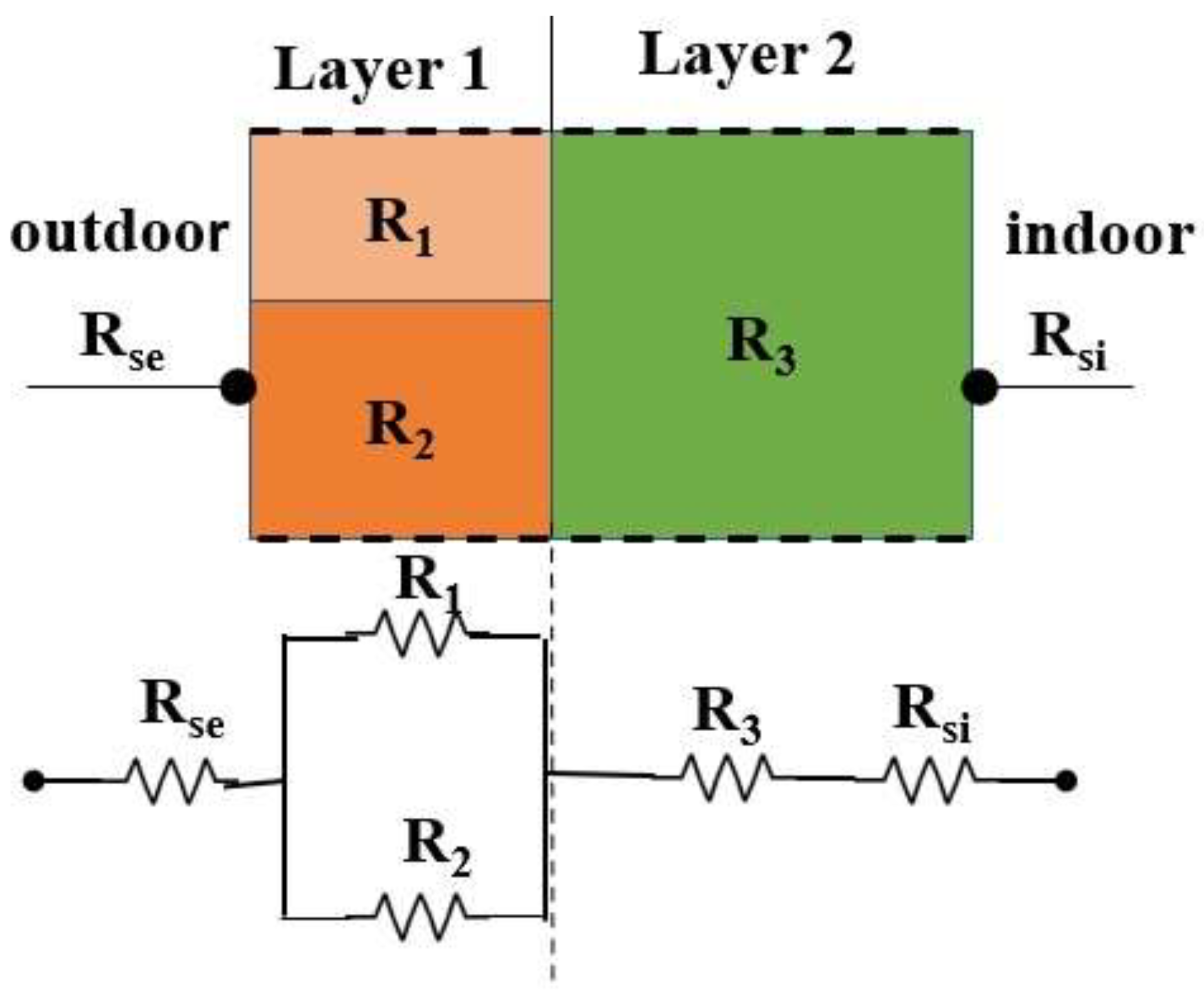


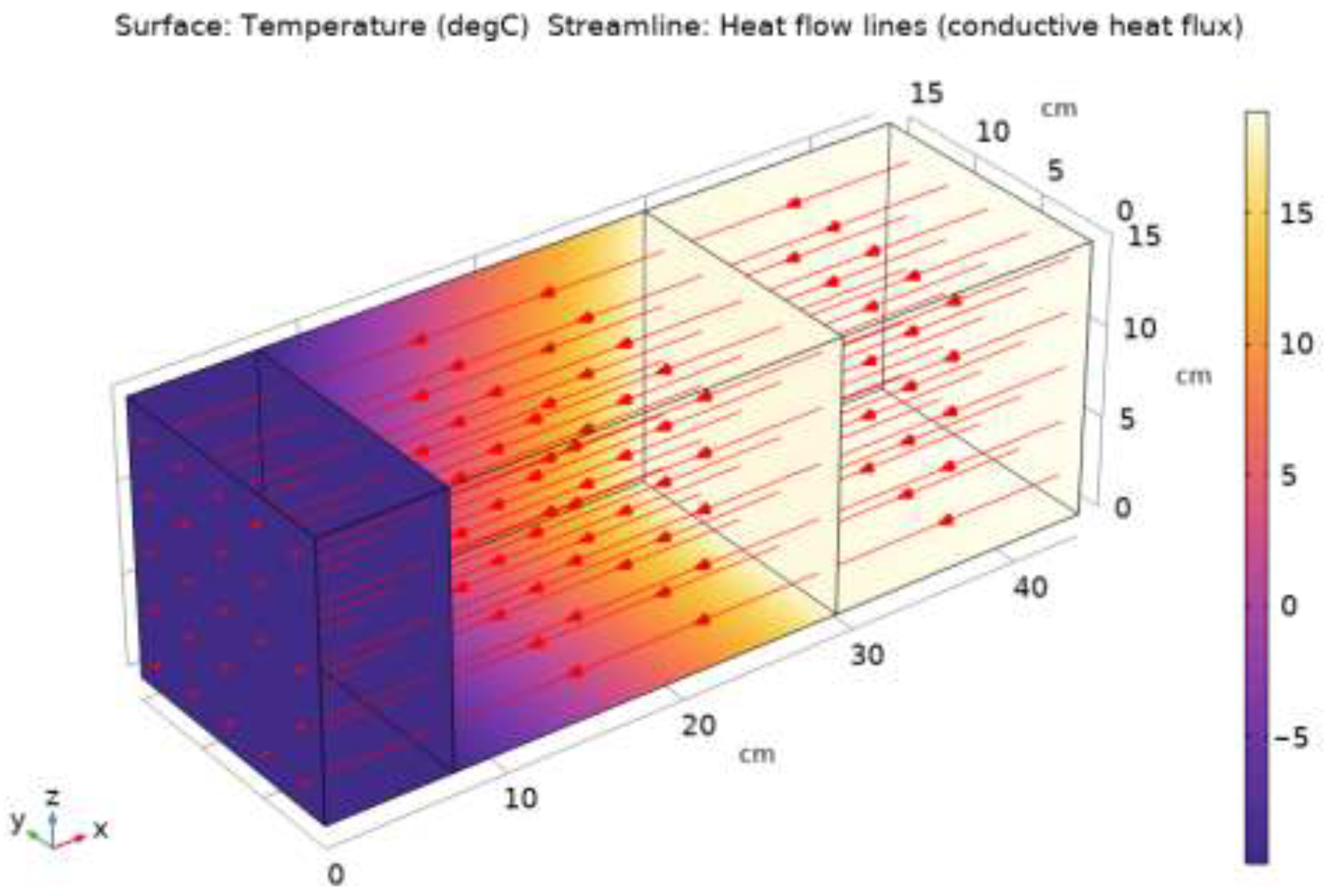
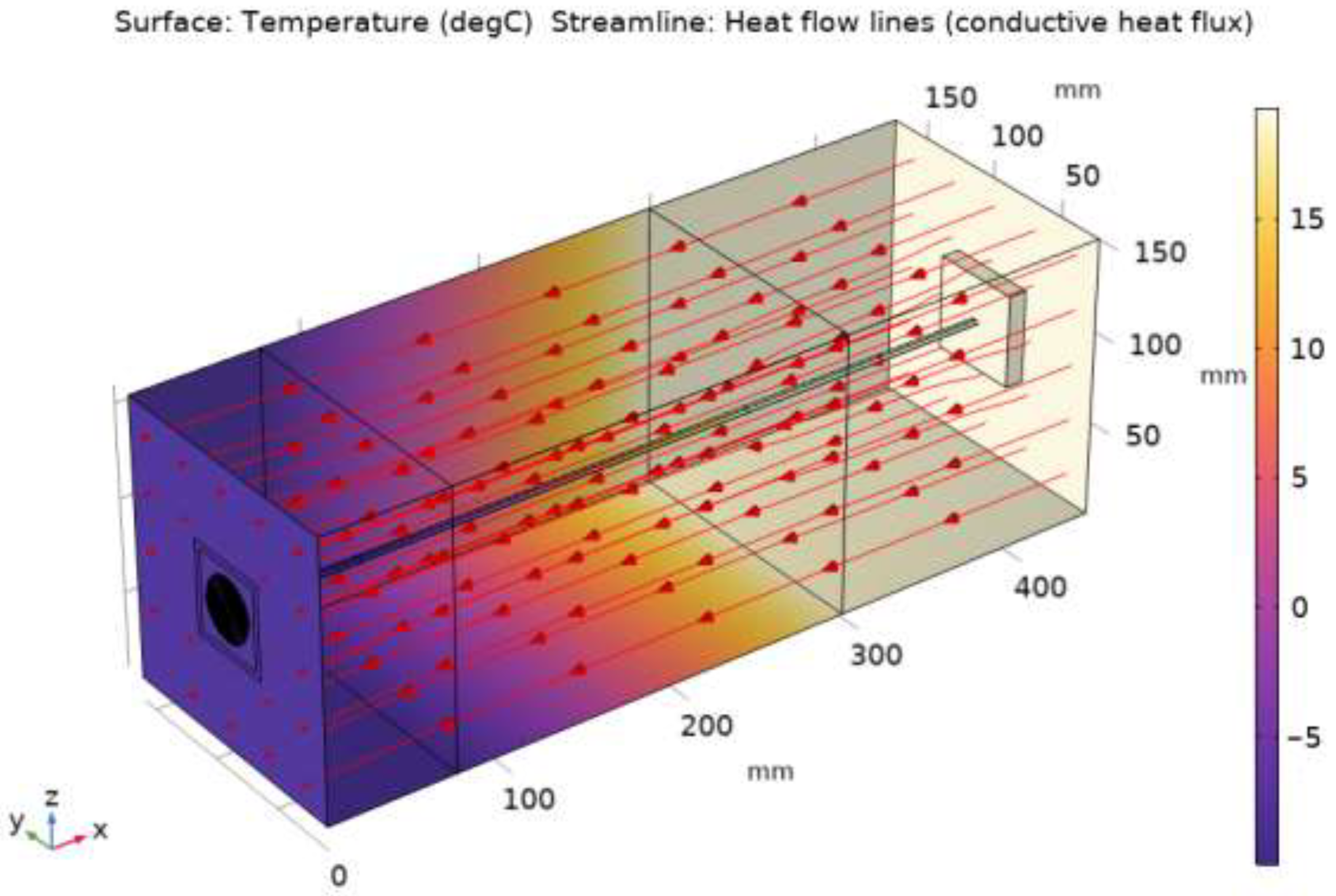
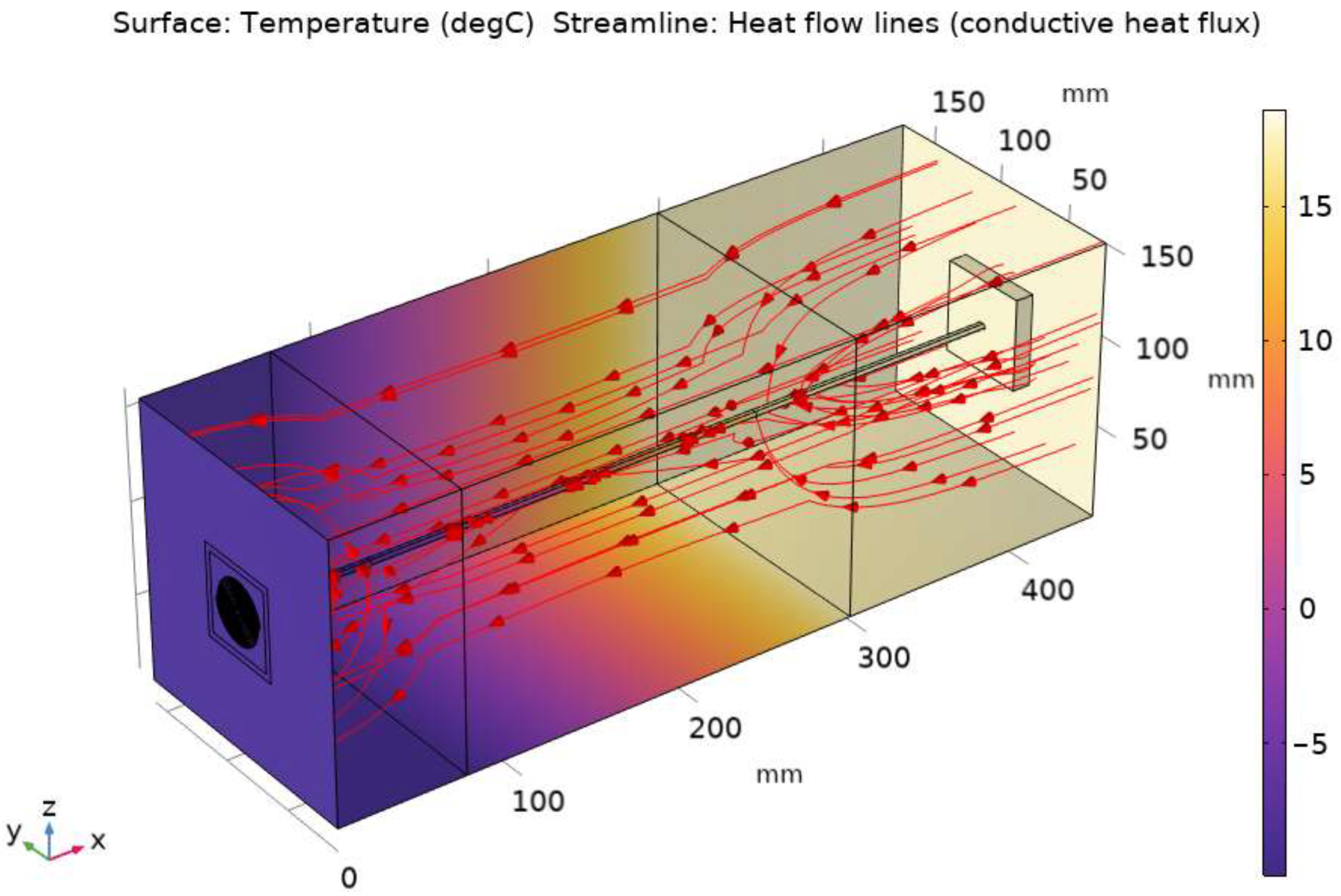
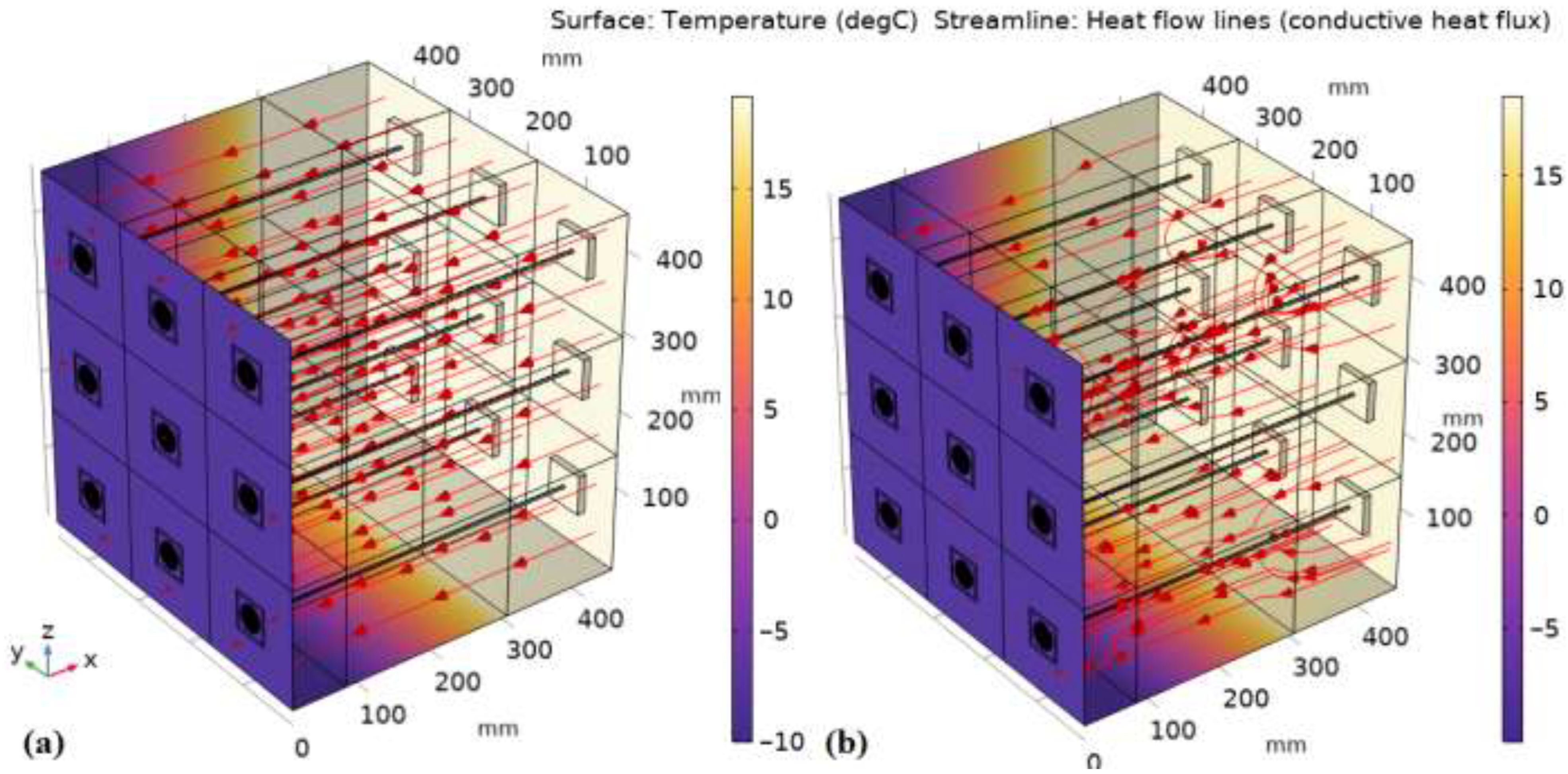
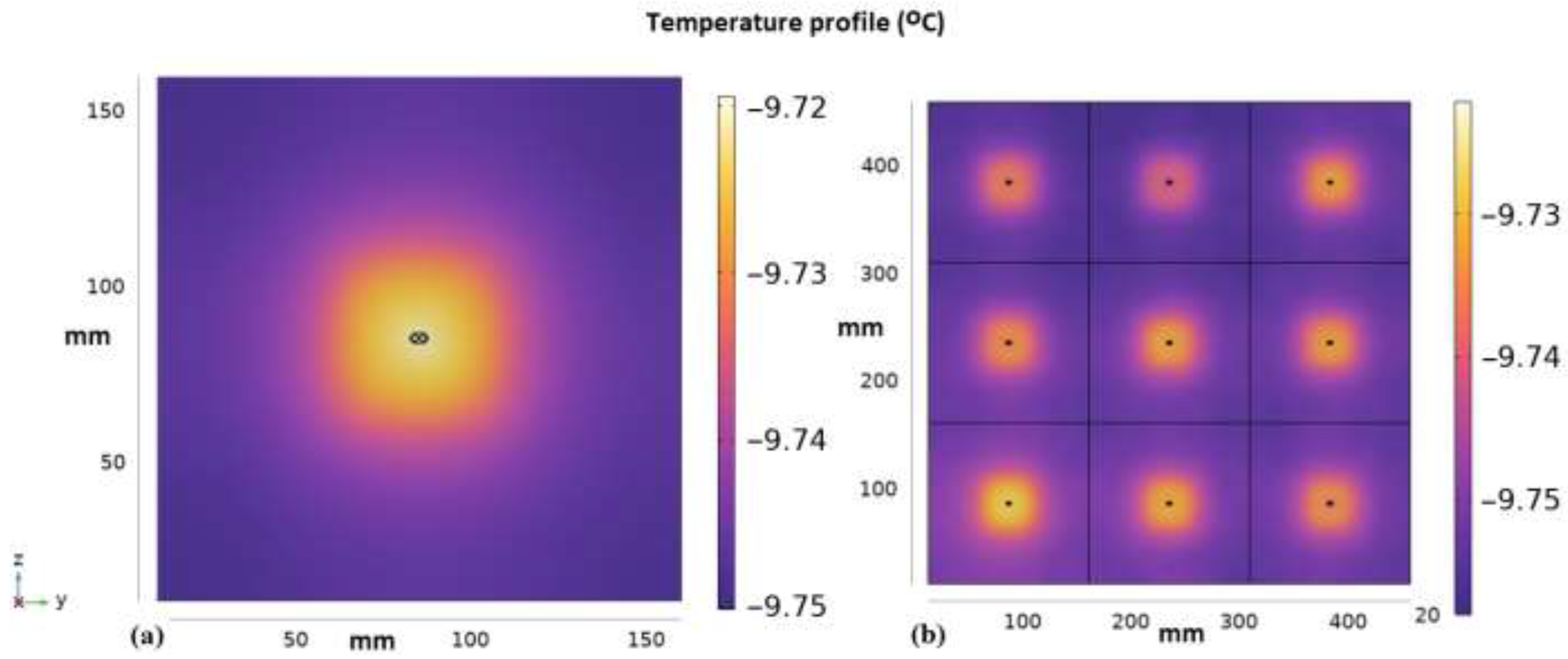
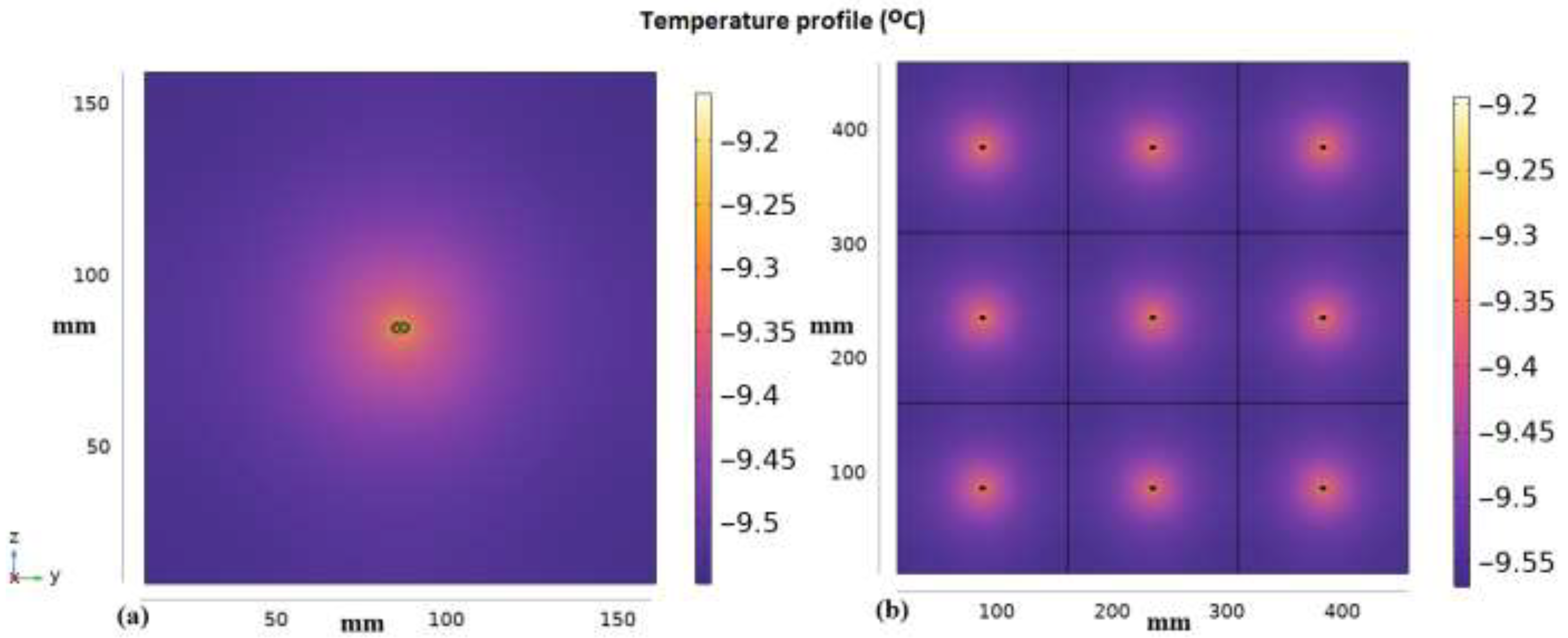
| Material | Density (kg/m3) | Thermal Conductivity (W/mK) | Specific Heat (J/kgK) |
|---|---|---|---|
| Concrete | 2400 | 2 | 1000 |
| Rockwool | 140 | 0.035 | 840 |
| Styrofoam | 15 | 0.04 | 1500 |
| PCB | 2200 | 0.2 | 960 |
| Rubber | 850 | 0.2 | 1900 |
| Stainless steel | 8000 | 15.2 | 500 |
| PTFE (Teflon) | 2000 | 0.24 | 1500 |
| Copper | 8960 | 400 | 385 |
| Materials of Connectors | U-Value (W/m2K) | |
|---|---|---|
| COMSOL Multiphysics | Stainless steel (current design) * | 0.156 |
| Copper (previous design) ** | 0.3 | |
| Parallel path | Stainless steel (current design) * | 0.153 |
| Copper (previous design) ** | 0.173 | |
| Isothermal planes | Stainless steel (current design) * | 0.157 |
| Copper (previous design) ** | 0.32 | |
| ISO 6946 combined | Stainless steel (current design) * | 0.155 |
| Copper (previous design) ** | 0.225 |
Disclaimer/Publisher’s Note: The statements, opinions and data contained in all publications are solely those of the individual author(s) and contributor(s) and not of MDPI and/or the editor(s). MDPI and/or the editor(s) disclaim responsibility for any injury to people or property resulting from any ideas, methods, instructions or products referred to in the content. |
© 2023 by the authors. Licensee MDPI, Basel, Switzerland. This article is an open access article distributed under the terms and conditions of the Creative Commons Attribution (CC BY) license (https://creativecommons.org/licenses/by/4.0/).
Share and Cite
Lu, T.; Vähä-Savo, L.; Lü, X.; Haneda, K. Thermal Impact of 5G Antenna Systems in Sandwich Walls. Energies 2023, 16, 2657. https://doi.org/10.3390/en16062657
Lu T, Vähä-Savo L, Lü X, Haneda K. Thermal Impact of 5G Antenna Systems in Sandwich Walls. Energies. 2023; 16(6):2657. https://doi.org/10.3390/en16062657
Chicago/Turabian StyleLu, Tao, Lauri Vähä-Savo, Xiaoshu Lü, and Katsuyuki Haneda. 2023. "Thermal Impact of 5G Antenna Systems in Sandwich Walls" Energies 16, no. 6: 2657. https://doi.org/10.3390/en16062657
APA StyleLu, T., Vähä-Savo, L., Lü, X., & Haneda, K. (2023). Thermal Impact of 5G Antenna Systems in Sandwich Walls. Energies, 16(6), 2657. https://doi.org/10.3390/en16062657







